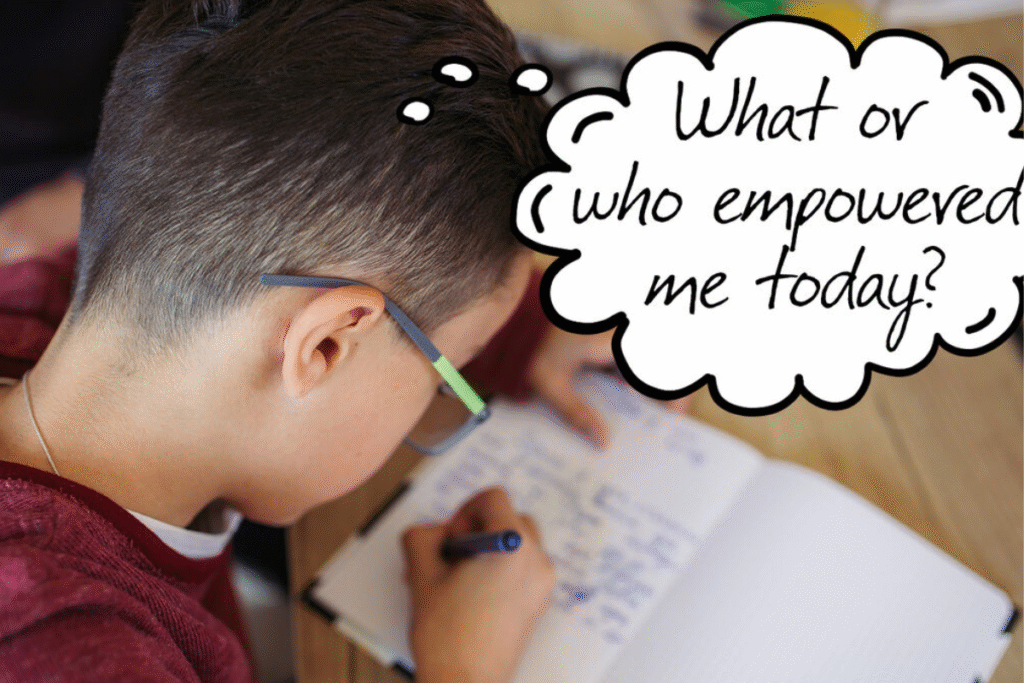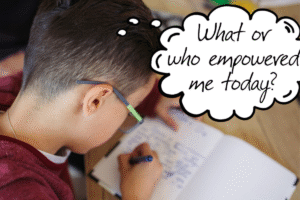Have you ever noticed how kids sometimes struggle to explain what they feel? Emotions like anxiety, sadness, or even excitement can swirl around in their heads, and it’s not always easy for them to talk about it. That’s where journal prompts for kids’ mental health can help. Think of journaling as a friendly tool that gives children a safe space to share their thoughts, explore feelings, and understand themselves better.
Journaling isn’t just about writing stories or doodling in a notebook. When kids use creative writing prompts for children, they start learning how to manage their emotions, boost self-esteem, and even practice mindfulness exercises for kids without realizing it. It’s like giving them a mini therapist in their own notebook!
One of the biggest benefits of using kids’ mental health journaling is that it encourages emotional regulation activities for children. By answering prompts such as “What made you happy today?” or “Describe a time you felt nervous,” children begin to recognize and express their feelings. Over time, this strengthens their emotional intelligence and helps them navigate tricky situations more confidently.
Parents and educators also love using journal prompts to help kids process big emotions because it creates a routine for self-reflection activities for kids. Kids not only write about what they feel but also learn grit, resilience, and coping skills, which are essential for mental well-being. And the best part? These prompts are fun and engaging! They can include drawing, coloring, or even imagining fantastic scenarios—all part of writing exercises for children to manage sadness and anxiety while keeping them entertained.
Beyond emotional growth, journal prompts to encourage creativity and self-discovery in kids help them explore ideas, dreams, and goals. Children can practice gratitude journaling for children, celebrate achievements, and even jot down small challenges they overcame, fostering a positive mindset.
In short, journal prompts for kids’ mental health act like a bridge—connecting thoughts, emotions, and creativity in a safe and enjoyable way. Whether your child is a quiet thinker, a playful dreamer, or a busy explorer, these prompts can guide them toward understanding themselves better, building resilience, and enjoying the adventure of self-awareness activities for children.
So, if you’re ready to see your child express their feelings, think creatively, and grow emotionally, this guide to kids’ mental health journaling is the perfect place to start. Let’s dive into a world of prompts that spark both imagination and emotional growth!
Benefits of Journaling for Kids’ Mental Health
Did you know that something as simple as a notebook can actually help kids feel calmer, happier, and more confident? That’s the magic of journal prompts for kids’ mental health. Let’s explore exactly why kids’ mental health journaling is so powerful and how it can change the way children experience their emotions every day.
1. Expressing Emotions Safely
Kids often feel emotions like sadness, anger, or anxiety, but they may not always know how to express them. Using journal prompts to help kids process big emotions, children can write down how they feel, why they feel it, and even what they can do to feel better. This is one of the best emotional regulation activities for children, helping them understand themselves without fear or judgment.
2. Boosting Self-Awareness
When children engage in self-reflection activities for kids, they start noticing patterns in their feelings and behaviors. Kids’ mental health journaling encourages them to think about their thoughts and actions, helping them develop emotional intelligence and a stronger sense of self. Questions like “What made me proud today?” or “How did I handle a challenge?” make kids more aware of their strengths and areas to grow.
3. Reducing Stress and Anxiety
Writing about worries and fears through writing exercises for children to manage sadness and anxiety can actually make those feelings feel lighter. Journaling creates a safe outlet for pent-up emotions, reducing daily stress and helping children feel calmer. Adding mindfulness exercises for kids into their journaling routine—like noting what they see, hear, or feel—boosts this calming effect even more.
4. Encouraging Creativity and Problem-Solving
Journal prompts to encourage creativity and self-discovery in kids don’t just support mental health—they also spark imagination. Children can doodle, make up stories, or explore “what if” scenarios, which strengthens creative thinking and problem-solving skills. Creative writing prompts for children make the journaling experience fun and engaging, so kids look forward to it rather than seeing it as a chore.
5. Fostering Gratitude and Positivity
Using gratitude journaling for children, kids learn to notice and appreciate the good things in life. Prompts like “List 3 things that made you smile today” or “Who helped you this week?” encourage positivity, optimism, and resilience. This simple habit can make a huge difference in how children feel about themselves and the world around them.
6. Building Healthy Habits Early
Finally, journal prompts for kids’ mental health help children develop routines that support emotional well-being. Writing regularly encourages consistency, responsibility, and mindfulness—skills that benefit them not just now but throughout life.
In short, journaling is more than writing—it’s a fun, creative, and effective way for kids to manage emotions, explore ideas, and grow emotionally. With the right journal prompts for kids’ mental health, children can turn their notebooks into personal guides for understanding themselves, expressing feelings, and discovering their inner strengths.
Age-Appropriate Journal Prompts for Kids’ Mental Health

Every child is unique, and the way they understand and express emotions changes as they grow. That’s why journal prompts for kids’ mental health work best when they’re tailored to age. By using kids’ mental health journaling that fits their developmental stage, children can explore their feelings, practice emotional regulation activities for children, and enjoy writing without feeling overwhelmed. Let’s break it down by age group.
Ages 5–7: Simple and Fun Prompts
At this age, kids are just starting to recognize emotions. Writing exercises for children to manage sadness and anxiety should be short, playful, and interactive. Prompts might include:
- “Draw a picture of something that made you happy today.”
- “Write one thing that scared you and one thing that made you brave.”
- “List 3 things you love about your family or friends.”
These prompts are part of gratitude journaling for children and encourage self-reflection activities for kids in a fun, engaging way. Using pictures and colors helps kids express feelings they may not have words for yet.
Ages 8–10: Reflection and Exploration
Children in this group can start thinking more deeply about their feelings. Journal prompts to help kids process big emotions can guide them through reflection and understanding. Examples include:
- “Describe a time you felt frustrated. How did you handle it?”
- “What is one thing you did this week that made you proud?”
- “Write about a time you helped someone and how it made you feel.”
These prompts support emotional regulation activities for children and encourage journal prompts to encourage creativity and self-discovery in kids, allowing them to explore personal experiences and build confidence.
Ages 11–13: In-Depth Self-Reflection
Preteens are ready for more detailed kids’ mental health journaling. They can use creative writing prompts for children and mindfulness exercises for kids to express complex feelings. Some prompts to try:
- “Write about a challenge you faced and what you learned from it.”
- “List three things you are grateful for and explain why.”
- “Describe a time you felt anxious and how you coped.”
These exercises strengthen self-reflection activities for kids and encourage emotional intelligence, resilience, and mindfulness. At this stage, journaling can even include goal-setting and problem-solving prompts, helping children plan for personal growth while managing stress.
By matching journal prompts for kids’ mental health to the child’s age, journaling becomes an enjoyable habit that supports emotional development, creativity, and gratitude journaling for children. Kids learn to recognize feelings, express themselves safely, and build habits that improve their mental health now—and for the future.
Themed Journal Prompts for Kids’ Mental Health
Sometimes, kids need a little guidance to express their thoughts and feelings. That’s where themed journal prompts for kids’ mental health come in handy. Using different themes, children can explore emotions, practice emotional regulation activities for children, and enjoy creative writing prompts for children in a fun, structured way. Let’s explore some of the most helpful themes.
1. Emotions and Feelings
Understanding emotions is the first step to emotional growth. Journal prompts to help kids process big emotions can help children identify and express how they feel. Examples include:
- “Write about a time you felt really happy and what made it special.”
- “Describe a moment when you felt scared or worried. What helped you feel better?”
- “Draw a picture of how your feelings change during the day.”
These exercises are excellent writing exercises for children to manage sadness and anxiety and help them practice self-reflection activities for kids.
2. Gratitude and Positivity
Prompts that focus on gratitude help kids see the good in their lives and develop a positive mindset. Examples include:
- “List 3 things that made you smile today.”
- “Write about a person who helped you this week and why you’re thankful.”
- “Draw your favorite moment from the day and describe why it made you happy.”
Incorporating gratitude journaling for children not only boosts mood but also strengthens emotional intelligence.
3. Creativity and Imagination
Encouraging imagination makes journaling more fun and helps kids explore self-discovery. Journal prompts to encourage creativity and self-discovery in kids might include:
- “If you could create a new world, what would it look like?”
- “Write a story about a superhero who helps kids feel brave.”
- “Draw or write about your dream adventure.”
These creative writing prompts for children make journaling playful and help children develop problem-solving skills and emotional expression.
4. Resilience and Coping Skills
Children face challenges, and journaling can teach them resilience. Prompts in this category help kids work through stress and practice healthy coping strategies:
- “Write about a time you tried something new and what you learned.”
- “List ways to calm yourself when you feel upset.”
- “Describe a challenge you faced and how you overcame it.”
These exercises are part of emotional regulation activities for children and writing exercises for children to manage sadness and anxiety, helping kids build confidence and persistence.
Using themed journal prompts for kids’ mental health makes journaling exciting, meaningful, and helpful for children of all ages. Whether your child is learning to express feelings, explore gratitude, or build resilience, these prompts guide them toward better emotional health and self-awareness.
Practical Tips for Parents & Educators
Journaling works best when kids feel supported, guided, and encouraged. Journal prompts for kids’ mental health can become a powerful tool in the hands of parents and educators who want to help children express feelings, practice emotional regulation activities for children, and enjoy self-reflection activities for kids. Here are some practical tips to make the most of journaling:
1. Create a Comfortable and Safe Space
Kids are more likely to open up when they feel safe. Set aside a quiet corner, provide colorful notebooks, pens, or stickers, and let your child know that their journal is private. This encourages honesty and makes kids’ mental health journaling feel like a fun, safe activity rather than a chore.
2. Set a Consistent Routine
Consistency helps children build habits. Encourage a regular journaling time—maybe before bedtime or after school. Using journal prompts to help kids process big emotions daily helps children practice writing exercises for children to manage sadness and anxiety, gradually improving emotional awareness and regulation.
3. Keep Prompts Age-Appropriate
Choose prompts that match your child’s age. Younger children (5–7) may prefer gratitude journaling for children with simple drawing prompts, while older kids (11–13) can handle more reflective creative writing prompts for children or journal prompts to encourage creativity and self-discovery in kids.
4. Encourage Expression Without Pressure
Remind kids that there are no “right” or “wrong” answers. The goal is self-expression, not perfection. Praise their efforts rather than results. This approach supports emotional regulation activities for children and helps them develop confidence in self-reflection activities for kids.
5. Integrate Mindfulness and Reflection
Add short mindfulness exercises, like noticing three things they see, hear, or feel, before journaling. This makes kids’ mental health journaling more focused and calming, helping them reduce stress and anxiety naturally.
6. Review Progress Together (Optional)
Occasionally, gently review past entries with your child. Celebrate achievements, reflect on challenges overcome, and discuss patterns in emotions. This can deepen the benefits of writing exercises for children to manage sadness and anxiety and strengthen emotional intelligence.
By following these tips, parents and educators can turn journal prompts for kids’ mental health into an enjoyable, effective daily habit. Children learn to express feelings, explore gratitude, build resilience, and discover themselves—all while enjoying the creative process.
Tracking Progress & Emotional Growth
One of the most powerful benefits of journal prompts for kids’ mental health is that they allow children to see how far they’ve come. When kids engage in kids’ mental health journaling regularly, they don’t just write—they learn to notice patterns in their thoughts, recognize their emotions, and celebrate their growth. Here’s how parents and educators can help kids track progress while keeping journaling fun and meaningful.

1. Encourage Reflection Over Time
Ask kids to revisit past entries occasionally. With journal prompts to help kids process big emotions, they can see how they handled challenges in the past and how their responses have improved. This supports emotional regulation activities for children and helps them understand that feelings change and can be managed effectively.
2. Celebrate Small Wins
Even simple achievements matter. Encourage children to note moments when they overcame fear, showed kindness, or solved a problem. Using self-reflection activities for kids in this way builds emotional intelligence, resilience, and self-confidence. Kids feel proud and motivated to continue journaling.
3. Identify Patterns and Emotions
By keeping up with writing exercises for children to manage sadness and anxiety, children and caregivers can spot recurring emotions or triggers. This insight helps them practice emotional regulation activities for children and encourages mindfulness exercises for kids, like noticing feelings without judgment and responding thoughtfully.
4. Use Prompts for Goal-Setting
Older children can use journal prompts to encourage creativity and self-discovery in kids for setting goals. Prompts such as “What is one thing you want to learn this month?” or “How will you practice being brave this week?” help kids develop focus and self-awareness while keeping journaling purposeful and engaging.
5. Encourage Positive Reflection
Incorporate gratitude journaling for children by asking them to list positive experiences or people who made a difference in their day. This not only enhances positivity but also strengthens the habit of noticing good things in life—a key part of kids’ mental health journaling.
Tracking progress turns journaling from a simple activity into a powerful tool for growth. Children learn to recognize emotions, celebrate victories, reflect on challenges, and develop healthy habits that support long-term mental well-being.
With journal prompts for kids’ mental health, children are not just writing—they’re learning, growing, and discovering the tools to manage feelings, boost self-esteem, and embrace their creativity.
Conclusion – Start Your Child’s Journaling Journey Today
Journaling is more than just writing—it’s a powerful tool for kids’ mental health. With journal prompts for kids’ mental health, children can explore their feelings, express emotions safely, and develop skills that last a lifetime. From managing anxiety and sadness to boosting creativity and self-awareness, journaling provides a safe and enjoyable space for kids to grow.
By using kids’ mental health journaling, children benefit from emotional regulation activities for children, writing exercises for children to manage sadness and anxiety, and self-reflection activities for kids. They learn to understand themselves, notice patterns in their emotions, and celebrate achievements. Adding mindfulness exercises for kids and gratitude journaling for children further enhances positivity and emotional balance.
Themed prompts make journaling fun and meaningful. From exploring emotions and feelings to practicing resilience, engaging in creative writing prompts for children, and following journal prompts to encourage creativity and self-discovery in kids, children can develop emotional intelligence while enjoying every step of the process.
For parents and educators, encouraging journaling is simple. Create a comfortable space, set a routine, provide age-appropriate prompts, and support children without pressure. Over time, kids will naturally adopt the habit of journaling, gaining confidence and self-awareness through kids’ mental health journaling.
So why wait? Start your child’s journey today with journal prompts for kids’ mental health. Watch them express themselves, discover their creativity, and develop resilience in a safe, fun, and supportive way. With the right prompts and guidance, journaling can become a lifelong tool that nurtures emotional growth, positivity, and self-discovery.
Your child’s next journal entry could be the first step toward a happier, healthier, and more confident version of themselves. Let the adventure begin!




